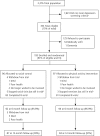Home-based activity program for older people with depressive symptoms: DeLLITE--a randomized controlled trial
- PMID: 20458104
- PMCID: PMC2866718
- DOI: 10.1370/afm.1093
Home-based activity program for older people with depressive symptoms: DeLLITE--a randomized controlled trial
Abstract
Purpose: We wanted to assess the effectiveness of a home-based physical activity program, the Depression in Late Life Intervention Trial of Exercise (DeLLITE), in improving function, quality of life, and mood in older people with depressive symptoms.
Methods: We undertook a randomized controlled trial involving 193 people aged 75 years and older with depressive symptoms at enrollment who were recruited from primary health care practices in Auckland, New Zealand. Participants received either an individualized physical activity program or social visits to control for the contact time of the activity intervention delivered over 6 months. Primary outcome measures were function, a short physical performance battery comprising balance and mobility, and the Nottingham Extended Activities of Daily Living scale. Secondary outcome measures were quality of life, the Medical Outcomes Study 36-item short form, mood, Geriatric Depression Scale (GDS-15), physical activity, Auckland Heart Study Physical Activity Questionnaire, and self-report of falls. Repeated measures analyses tested the differential impact on outcomes over 12 months' follow-up.
Results: The mean age of the participants was 81 years, and 59% were women. All participants scored in the at-risk category on the depression screen, 53% had a Diagnostic and Statistical Manual of Mental Disorders or International Classification of Diseases, Tenth Revision diagnosis of major depression or scored more than 4 on the GDS-15 at baseline, indicating moderate or severe depression. Almost all participants, 187 (97%), completed the trial. Overall there were no differences in the impact of the 2 interventions on outcomes. Mood and mental health related quality of life improved for both groups.
Conclusion: The DeLLITE activity program improved mood and quality of life for older people with depressive symptoms as much as the effect of social visits. Future social and activity interventions should be tested against a true usual care control.
Figures





References
-
- Baldwin R, Chiu C, Katona C. Guidelines on Depression in Older People—Practicing the Evidence. London: Martin Dunitz Ltd; 2002.
-
- Bruce ML, Hoff RA. Social and physical health risk factors for first-onset major depressive disorder in a community sample. Soc Psychiatry Psychiatr Epidemiol. 1994;29(4):165–171. - PubMed
-
- Blumenthal JA, Babyak MA, Moore KA, Craighead WE, Herman S, Khatri P, et al. Effects of exercise training on older patients with major depression. Arch Intern Med. 1999;25;159(19):2349–2356. - PubMed
-
- Gill TM, Baker DI, Gottschalk M, Peduzzi PN, Allore H, Byers A. A program to prevent functional decline in physically frail, elderly persons who live at home. N Engl J Med. 2002;347(14):1068–74. - PubMed
Publication types
MeSH terms
LinkOut - more resources
Full Text Sources
Medical
